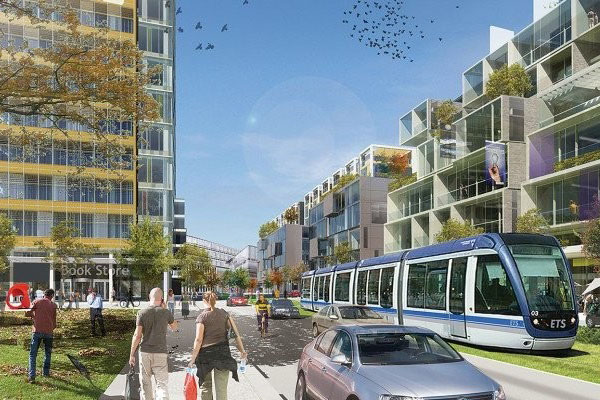|
RCBJ-Audible (Listen For Free)
|
Sterling Development Group Proposed a 252-Unit Multi-Family Development But For Now Is No Longer At The Table
By Tina Traster
After years of waiting for a developer to jumpstart residential housing in the rezoned Nanuet downtown, there was optimism over a proposal by an experienced New Jersey home builder.
But with no notice, Sterling Development Group, LLC withdrew an application from the Rockland County Industrial Development Agency, leaving officials unsure as to why or whether this is a temporary hiatus or whether the developer had moved on.
“This is news to me,” said Ward Three Councilman Don Franchino, who said town officials as of Wednesday were also unaware of the departure. But Franchino said town officials were excited because they believed the Cohen family had finally sold a significant parcel to Sterling, and that a housing plan would kick off the vision for a downtown cluster of homes and businesses in close proximity to the Nanuet Train Station.
Phone calls and emails to Nick Hollenbeck of Sterling Development Group of Livingston seeking comment were unanswered.
The Rockland County Industrial Agency voted 4-0 on June 13 and passed an Authorizing Resolution on Sterling Development Group’s application for a PILOT (payment in lieu of taxes) to build the first project in Clarkstown’s Nanuet Transit Oriented Development at 31 Prospect Street. The land is zoned TOD-1 and TOD-2 which both allow multifamily residential development.
Sterling was not seeking either a mortgage tax or sales tax abatement in its application with the IDA. PILOTs in Rockland County are negotiated with the local taxing authorities, not with the IDA. Most PILOT programs run 15 years; Sterling sought a 20-year PILOT. No plans were submitted to the Town’s Planning Board.
Sterling’s application stated that it planned to acquire 5.56 acres of land from RIMZCO, LLC and 18 + 26 Prospect NY, LLC (the Cohen family enterprises), for $20 million. The application also said the developer would invest an additional $86 million to complete the project, representing a per-unit average cost of $421,477, or about $345 per square foot.
But Sterling, as many applicants say, claimed the project is not possible without a long-term 20-year PILOT program that would tax the land as essentially vacant ($42,148 per year) for the first five years with a 2 percent increase each year. In year six, each unit would be taxed at $3,000 per unit (regardless of size) and increase 2 percent annually through year 15. In year 16, each unit would be taxed $4,000 and increase 2 percent annually until year 20 when the assessor would be free to re-assess the units.
A cost-benefit analysis, prepared by the developer states the “long-term fiscal benefits of the project exceed $13 million and that the impact on the local school district will be negligible.”
The Making of the Nanuet TOD
It took nearly ten years of public meetings, steering committees, workshops, scoping documents, and environmental impact statements to craft a Transit Oriented Development (“TOD”) around the Nanuet Train Station in the Town of Clarkstown. The idea was to encourage development of millennial and senior housing in smaller units close to the Nanuet downtown corridor and the commuter rail to Bergen County and New York City.
In June 2019, Clarkstown voted to rezone the heart of Nanuet’s business district into a cluster of dense residential housing and light commercial that is designed for walkability and train use. The 37-acre TOD, which is divided in three parts, caps housing units at 500. The original plan called for 750 housing units but was downsized to satisfy New York State Department of Transportation’s traffic concerns on state roads.
The goal of the Nanuet TOD, which situates housing close to transit, is to replace commercial and industrial uses with a vibrant “downtown” community surrounded by a single-family subdivision, Nanuet’s Main Street, and the Shops at Nanuet to the north. However, existing businesses in commercial buildings are grandfathered as pre-existing nonconforming uses for as long as they operate. A non-conforming use cannot alter its footprint without a variance.
In the spring of 2022, Clarkstown went back to the drawing board on the TOD zoning again – largely to accommodate one property owner by allowing greater density on the parcel owned by the Cohens – the family that owns the land Sterling Development says it intends to purchase.
The revisions also incorporated the Grace Baptist Church into the TOD plan.
Grace Baptist Church Could Become Site For Future Multi-Family Housing
“The blueprint has been the same from day one,” said Franchino. “Cohen wants to sell the land. Plans get approved. The family backs out. And nothing happens.”
But Franchino said the town’s recent acquisition of a $475,000 state grant to demolish the church could change the playing field because “the church site is now part of the TOD and there is a cap on how many units can be built.” Taxpayers will have to make up the balance of what is expected to be a $1 million demolition cost because of the asbestos removal.
According to the IDA application, Sterling proposed a 252-unit multifamily residential development with 12,000 square feet of amenity space, a 5,000 square-foot public park, and 1,000 square feet of indoor space for use by the Nanuet Chamber of Commerce.
Other amenities listed include a golf simulator, fitness on demand, concierge, dog park and dog washing station, and resident event space.
The submission proposed 22 studio apartments with projected rents of $2,350 per month; 47 one-bedroom units at $2,700 per month; 47 one-bedroom with dens at $2,900 per month, and 123 two-bedroom units at $3,450 per month.
The project also contemplates 13 affordable units of an unspecified size at $1,300 per month.
Sterling’s application had stated that the 252 units will only add 10 students to the public schools, and that the average annual spending per the 524 proposed residents (252 units x 2.07 persons per unit) will be $5,000 each, or $2,620,000 per year.
It is unclear as to whether the developer will be back. Sterling has completed more than 20 high-end housing complexes in New Jersey, Pennsylvania and in Middletown and Wappingers Falls.
In addition to IDA approval for the PILOT, the developer would have still needed to secure agreements from the town and the local school district.












